Leaving the Simien Mountains National Park behind did not mean we were leaving the beautiful scenery behind. The road leading from Debark to our next destination, Axum, was about the most beautiful road I had seen in all of Ethiopia, and that is saying a lot because they are all beautiful! That is one aspect that we all mentioned over and over, the incredible beauty of the roads as we twisted and turned and wound our way up and over the mountains, meeting ourselves coming back around the switchbacks.

The road leading out of Debark was a bit harrowing, with steep drop-offs and no guard rails.
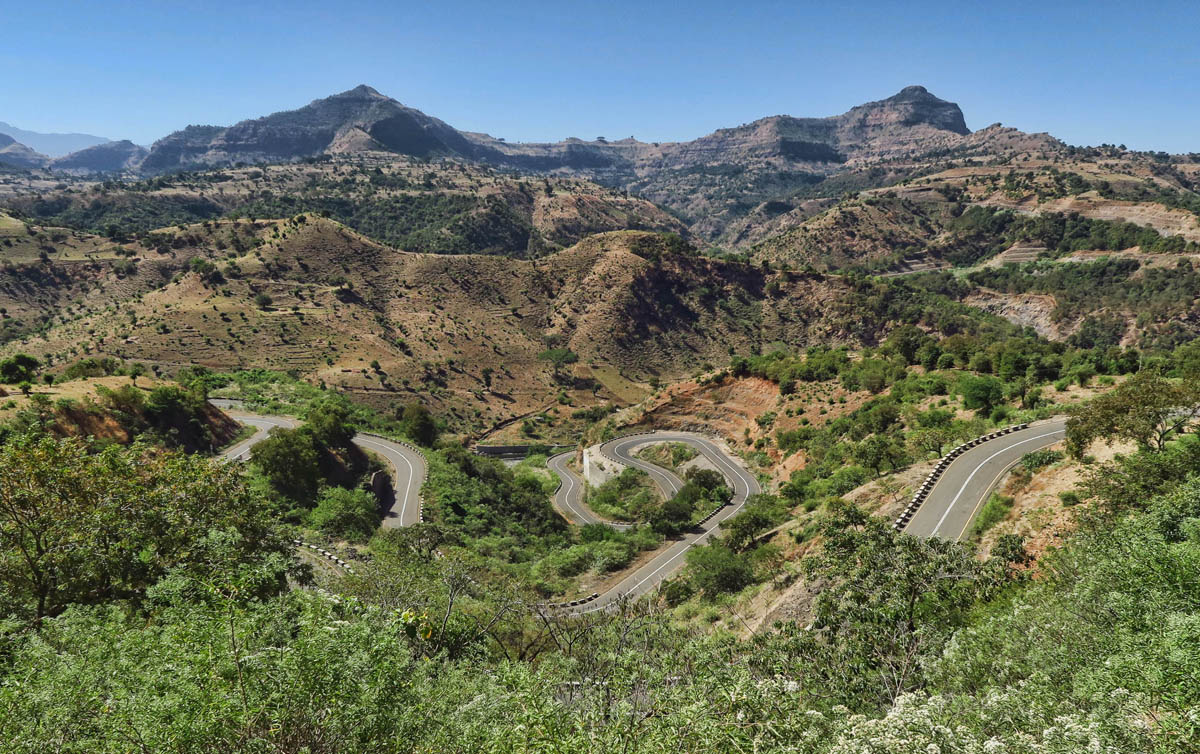
This is the best road! It looks like a snake coiled around and around.

Each time we would stop, whether it was for lunch, a photo op, or a “pee stop,” the minute the wheels stopped, kids would come running out of nowhere as hard and fast as they could run. This young man in the middle has an animal hide for sale. Sometimes, they would even try to sell or trade the tee-shirts they were wearing.

This iconic “skyline” profile is seen frequently in tourism brochures.

A beautiful volcanic crater formation along the way to Axum.
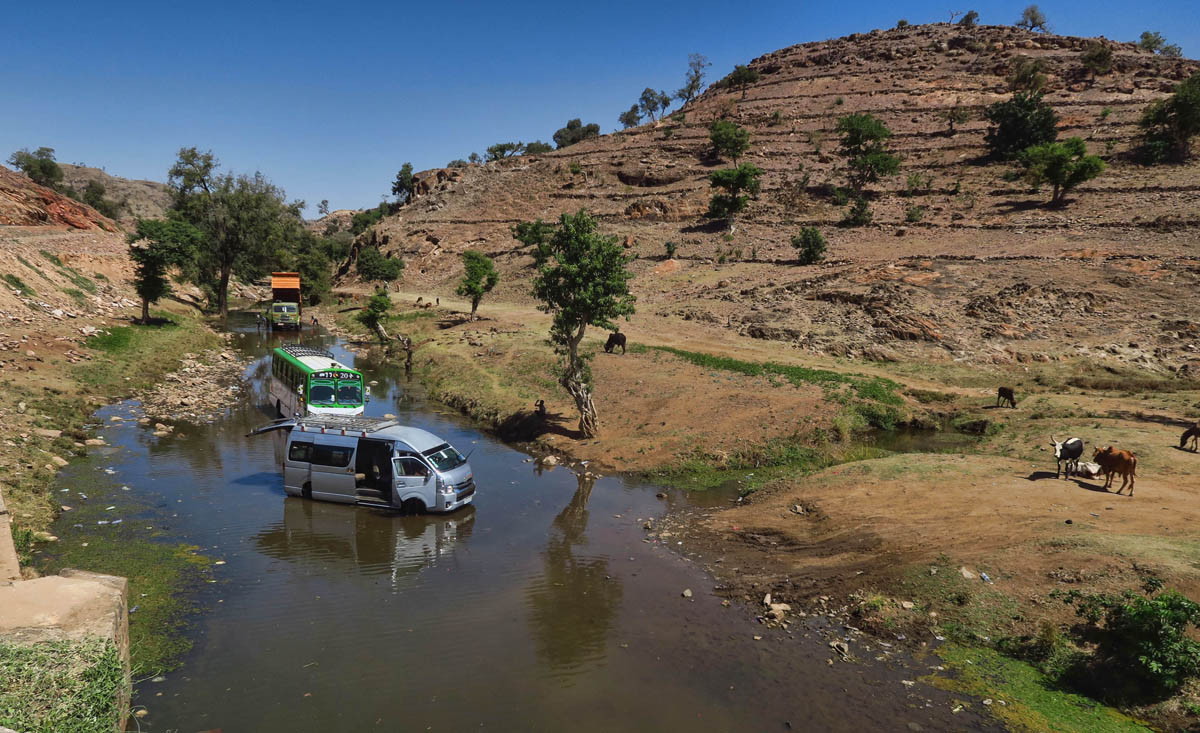
Ethiopian Car Wash — along the road to Axum

These are my buddies from the tour. L to R, Lynette (my lovely roomie) from England, Jasper, Air Traffic Controller from Belgium, and his best friend Sarah, also from Belgium. They were a fun group, and very kind to let an old lady like me “hang out.” We had a lot of laughs.

This is “injera,” staple diet of the Ethiopians for breakfast, lunch, and dinner. The base is a spongy pancake made from fermented “teff” grain like sour dough. The pancake is used both as a plate, as well as a utensil as you rip off strips using them to scoop a bite of the side dishes. Items around it are potatoes, collard greens, lentils, spicy lentils, chick peas, salad, and more. While meat is available as a special order, it’s mostly always vegetarian. Ethiopians “fast” (don’t eat meat) 255 days out of the year. So all one has to do is order from the “fasting menu” to be assured of veganism.
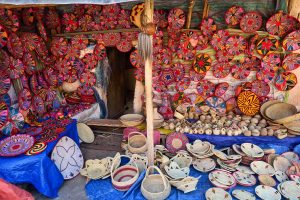
I am not a shopper, so aside from a couple of reptile handbags here and there, the blog falls short for those who like to shop. However, this basket shop was colorful enough to warrant a stop.
We were headed northeast toward the ancient city of Axum, or “Aksum,” depending on one’s nationality, once the historic capital of the Aksumite Empire, ruling the region from 400 BC to the 10th century. It was at one time the most powerful state between the Eastern Roman Empire and Persia (what is now Iran,) and one of the first Christian countries in the world, having officially adopted Christianity as the state religion in the 4th century. Unlike so many African countries where Christianity is brought by missionaries, here in Ethiopia, it’s “home grown.”
As a result, Ethiopia’s Coptic Orthodox Christianity is filled with fables, folklore, legends and lifetimes of stories told like the old game of “Telephone.” All debated and disputed, rebuked and rejected, yet these tales perpetuate for centuries dictating celebrations, festivals, calendars (Ethiopia has its own calendar…it’s 2012 now, yet I didn’t feel any younger!) and traditions, all centering around a series of events that are celebrated even more than the Christ himself. At the center of it all is the Ark of the Covenant, a gold-coated wooden box containing the remnants of Moses’ tablets of the Ten Commandments. Allegedly, this box containing the tablets is stored under lock and key in a forbidden chamber in the “Chapel of the Tablet” on the grounds of the Church of Our Lady Mary of Zion, right here in the heart of Axum. Though only “one person” gets to see it, the Christian monk who keeps guard. Forgive me if I seem skeptical.

Looking down on the north stellae field. When Timkat festival is not taking place, this is one of Axum’s prime tourist attractions.
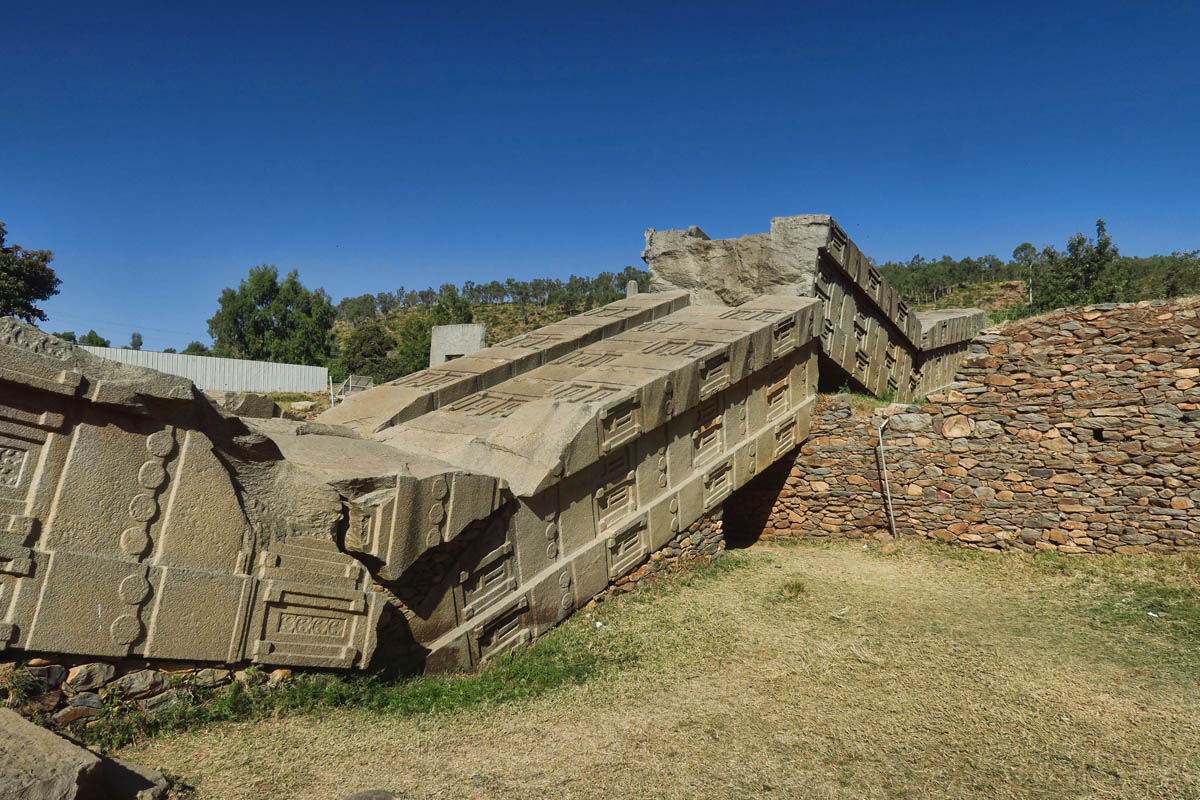
These obelisks are around 1,700 years old, the largest of which is 108 ft long, weighing in at 520 tons, the Great Stellae, believed to have fallen and broken during construction due to an insufficient foundation.

The second largest, Obelisk of Axum, 80 ft high, weighing 170 tons was taken by the Italian army in 1937 as a war trophy. It was returned to Ethiopia in 2005 and reinstalled July 31, 2008. It took the United Nations to coerce the Italians to ship it back.
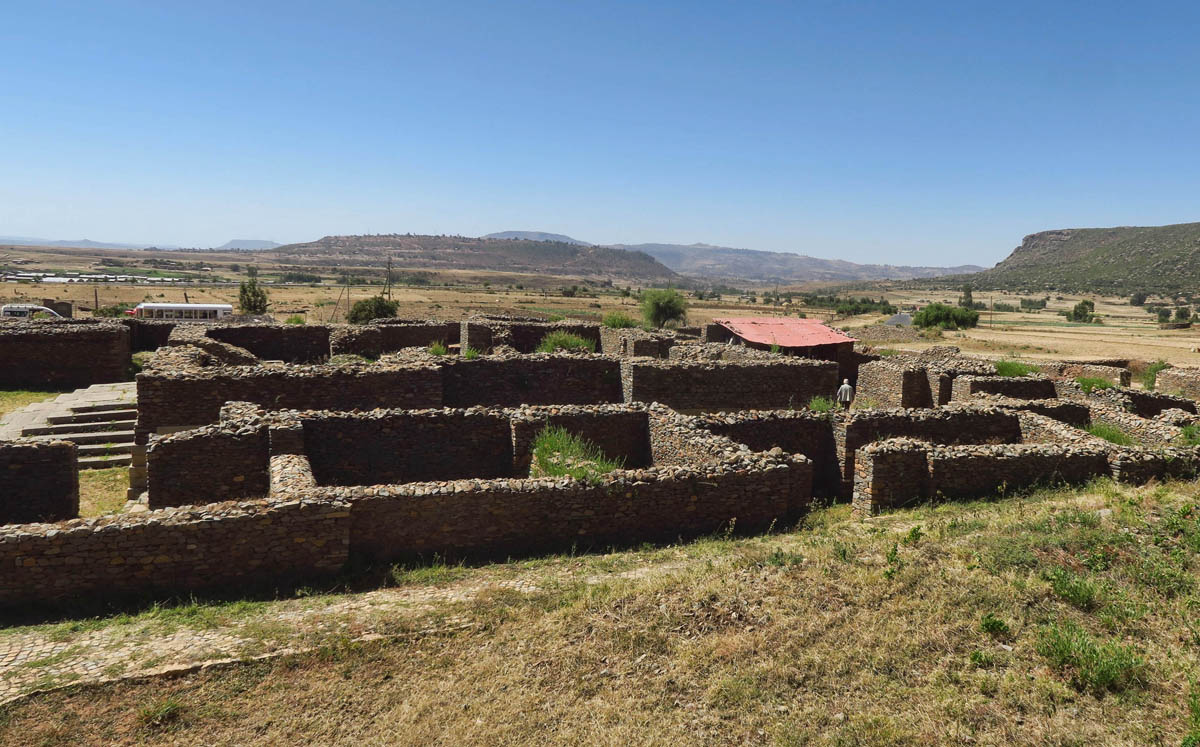
Billed as the “Queen of Sheba’s Palace,” though architects have said the timeline does not support this theory, as it dates closer to the 6th Century AD. However, they have recently discovered some more ancient ruins beneath these, so who’s to say?
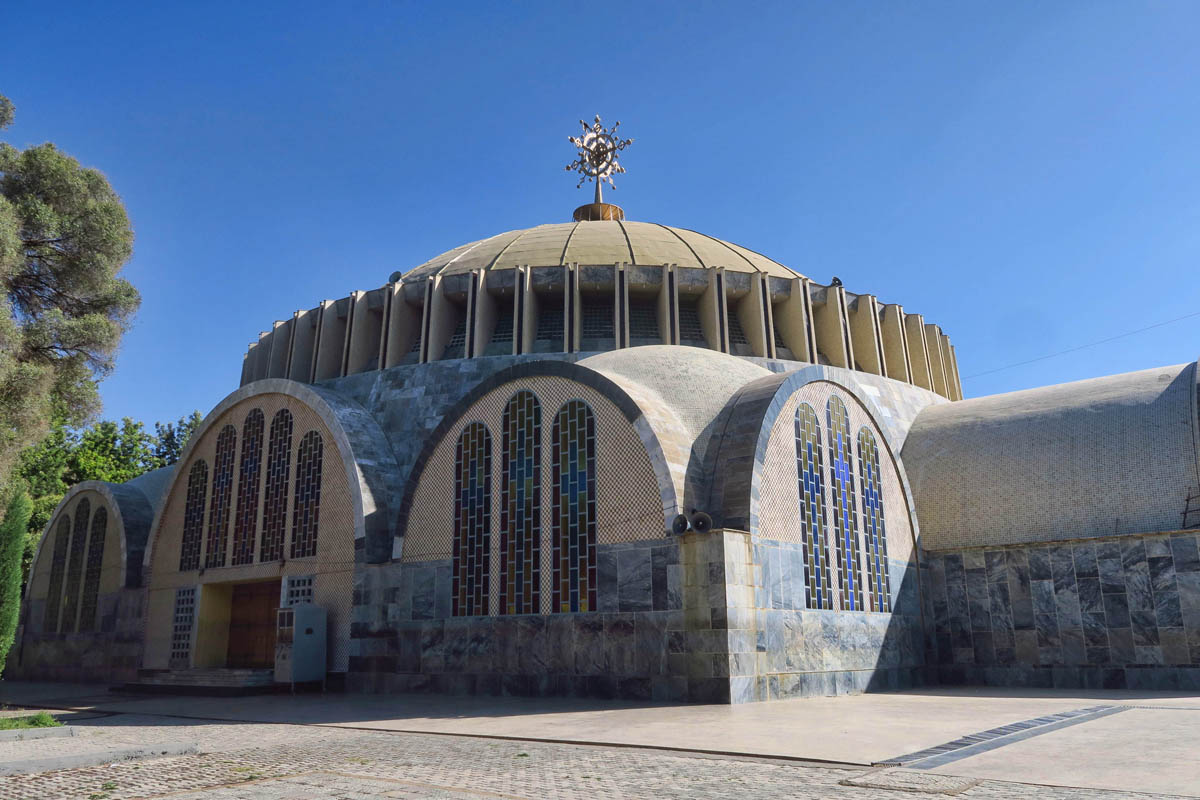
The original Church of Our Lady Mary of Zion has been destroyed twice. This monstrosity of a replacement was built in the 1950’s.

And here it is…Chapel of the Tablet where the Ark of the Covenant is enshrined. But no one is allowed to see it, or get any closer than this in fact. So you be the judge.
All Ethiopian churches have three chambers. The first can be visited by man and woman alike (though through separate doors.) The second chamber can only be visited by men and priests. And the “Holy of Holies,” the third chamber, can only be visited by the high priests. In this third chamber every Ethiopian Coptic Christian church houses their own personal replica of Moses’ tablets, placed inside a replica of the Ark of the Covenant. This replica is trotted out sometimes on a platform beneath a large colorful umbrella, and carried through the streets on the shoulders of men. Sometimes it is draped in embroidered cloth and carried on the heads of priests like a headdress. Either way, it makes an appearance at every religious festival.
The way the story goes as to how the Ark of the Covenant ended up in Ethiopia is by way of the ancient Ethiopian Queen of Sheba (it was okay to have a woman as a ruler back then, though now thousands of years later, women are not even allowed in some parts of the church?) Sheba made a pilgrimage by camel to the Holy Land around 1000 BC. She traveled to Israel to meet King Solomon. While away, they had a vacation fling, and she came back to Ethiopia with more than a few souvenirs of incense and myrrh….she returned with King Solomon’s love child. “Summer dreams ripped at the seams, but oh oh those su-uh-mmer nighhhts!”
Apparently this pilgrimage is documented in the Old Testament, but who am I to say? I never made it past Genesis. But the event is also mentioned in the Qu’ran as well, so at least there was some corroboration of stories back then.
Sheba gave birth to a son, Menelik, who grew up in Ethiopia but traveled to Jerusalem as a young man to visit his father’s homeland. He lived several years in Jerusalem but when the Babylonians invaded Jerusalem, Menelik, along with his entourage fled, allegedly stealing the Ark of the Covenant and bringing it home to Axum.
Axum is considered to be the holiest city in Ethiopia, therefore it’s an important destination of pilgrimages and religious festivals. And we have somehow by the luck of the draw, ended up during one of the biggest of them. The three day festival of “Timkat,” (known as Epiphany in western Christianity) is Ethiopia’s second largest Christian festival, eclipsed only by Ethiopian Christmas. It marks the baptism of Christ in the Jordan River. And it is happening just as we roll into town. I can’t believe our good fortune to experience this festival in the place where it supposedly all began!
Do I believe the Ark of the Covenant is located here in Axum? Honestly, I don’t think such a thing exists anywhere. But just like observing the processions of the Virgin Mary in Mexico, Jews at the Western Wall, or Muslims completing the Haag, it’s inspiring to observe those who do.

The Timkat Festival, known as Epiphany in western Christianity, is gearing up in the streets outside our Axum hotel.
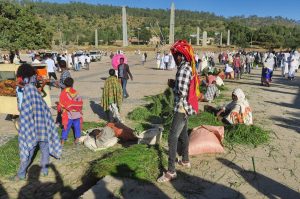
This fresh grass, along with sprigs of mint are being sold. Tradition dictates it is strewn on the floor during the festival.
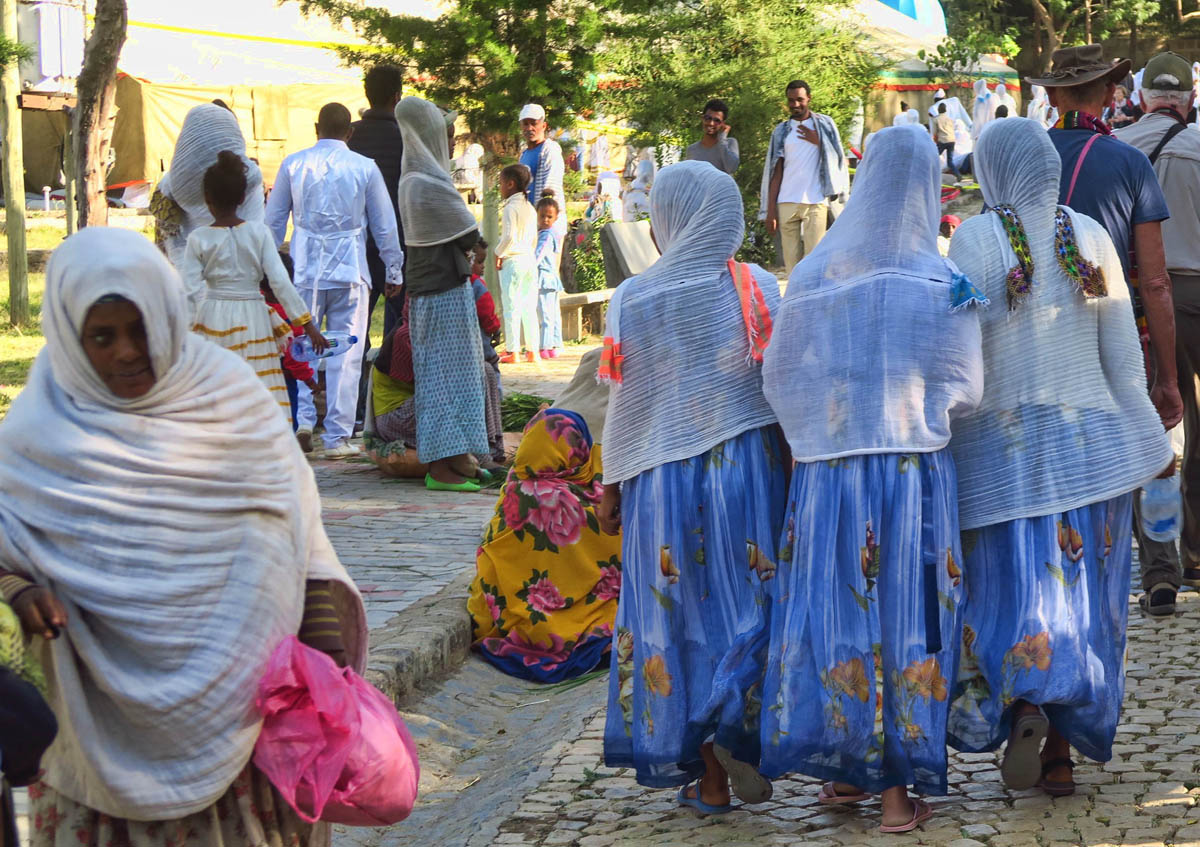
Timkat is a time when women wear their finest. A lot of young girls, both friends and sisters, wear the same dresses.
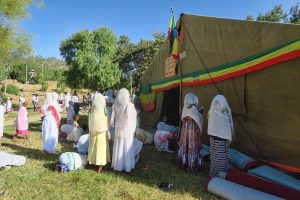
This is a “revival tent” of sorts, where the replica of the Ark is kept until it begins a procession through the streets. Women are not allowed in, so they are praying outside.
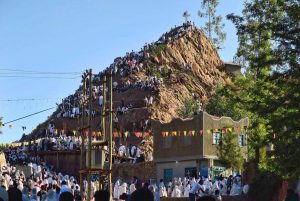
Timkat is a festival to reenact the Baptism of Jesus in the Jordan River. In Axum, it takes place at a reservoir which was purported to be “Queen Sheba’s Pool.” These people have climbed up the mountain for a better look as the priest blesses the water in the reservoir, turning it into “Holy Water.”
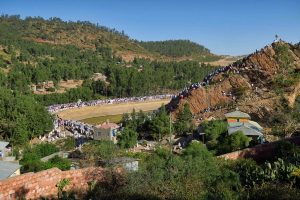
We can’t even get close to the reservoir during the blessing, so we climb up to a lookout point to try and get a look at the pool in the distance.
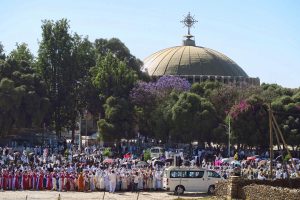
The procession passes in front of the dome and bell-tower of the Church of Our Lady Mary of Zion.
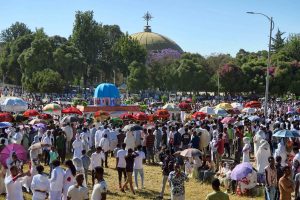
Beneath the blue umbrella is the local replica of the Ark of the Covenant, draped in cloth.
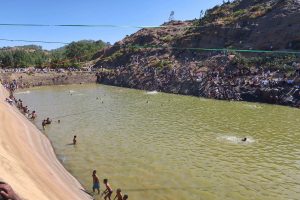
Since the procession has now left the baths, we head back for a closer look. Young boys are swimming (women are forbidden!) Those that can’t swim go down to the water’s edge with bottles for filling with holy water.

This is really a time for women to “see and be seen” rather than their usual routines within the home. Women dress up in their Sunday best and stride around regally like Nubian princesses.
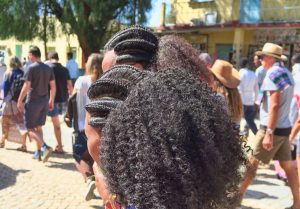
These two women have “Timkat hairstyle” whereby the crown is braided, and the back is blown out.
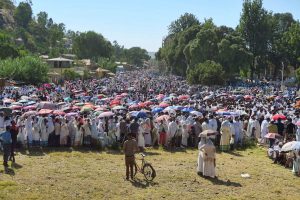
This is the mass exodus down the main street from the church, once the “baptism” blessing has finished.

Back on the road leaving Axum headed to Mekele, we encounter another Timkat festival in a small village. Here’s what it looks like to drive through…

Louise gets out to direct traffic, as we must turn around and take a side road. “Which of these is not like the other?”

The women were chanting to drumming music.

Leaving Axum headed east, the scenery is just as beautiful as it was coming in from the west.

Some serious switchbacking required to get up the mountain.

On the way to Mekele, we stop at one of the Tigray rock hewn churches, Wukro Chirkos. It is a monolith, carved from a single piece of rock in the form of a cross-in-square, believed to have been created between AD 700 and 1000.

Prior to the churches in Lalibela being discovered in the early 20th century, Wukro Chirkos was the only rock-hewn church known to the outside world.

So many thanks for providing your fans with these lovely photos of places that we will never see in person.
Virtual hugs,
Judie
This trip continues to amaze and please us. thanks
What a great trip, its very interesting . Like a good book I look forward to the next chapter.
Wow! You certainly are sending me to Google a lot!! I am learning so much and really looking forward to your next posting!!
Suzanne,
You are once again illuminating beautifully parts of the world so little seen! Your very honest way of presenting its history makes it seem even more real than sites like the Great Pyramids in Egypt or the Roman Colosseum. These places in the Sudan and Ethiopia you are sharing feel authentic whereas other ancient sites seem almost like a Disneyland recreation. Thank you again!
One question, here and now we are reading about the huge swarms of locusts? Were they not in the areas you visited or was it a timing difference?
Wow, Jim, I had no idea! The blog always runs a little behind. I left Ethiopia the second week of February (in Southern India now.) The only insects I saw were a couple of annoying mosquitoes. No sign of any locusts, thankfully! I googled it to see where they were, and that looks like quite a fright. Grateful to have missed it! Those poor people work so hard at growing food, seems like they need a break! Thanks for the question.
Glad you missed them, but on the other hand seeing a plague of biblical proportions would be interesting if you knew you were leaving in a few days…. kinda like watching a twister headed toward you and being able to click your heels before it hit!
Chanting women (Louise really stands out in that crowd!), tiny switchbacks with no guard rails for a BIG bus, a temple carved from one rock! masses of believers in a rarely seen thousand-year ritual by Westerners, car washes in a natural pool! an African culture from the Old Testament who believed in Christ without missionaries! Wow, totally amazing! Who would have thought! And by the way, I could have eaten that entire plate of injera, did you have to share with the others?
Hi, Terri. We four shared that plate, but the restaurant gave “free refills,” so more was ours for the asking. We did get more of the spicy lentils, the “shiro,” (paste made from powdered chickpeas) and the greens. Extra injera came rolled up like a table napkin. LOL!
This was my first time eating injera. I did eat it a few more times along the way, just because having no meat, it often seemed like the safest choice on the menu….that, or french fries. While I liked the “sauces and sides,” I didn’t care for the injera itself…too much like a thin slice of foam rubber. Consequently I ate a LOT of french fries!
Yeah, the “foam rubber” was just a conduit for the good stuff 🙂
Suzanne, I can only add my “ditto” to the thoughtful comments above. Thank you. Thank you. Thank you. I have enjoyed being on this trip with you! Sharon
That Timkat hairdo! Those roads! Your travels! Rave on Suzanne! (In reference to the Van Morrison song (“Rave On, John Donne”).
https://www.youtube.com/watch?v=26W2Ybiq-jU
What a great post! So interesting! I spied with my little eye some tourist-looking individuals in one of your photos. I’m not sure why, but I figured you guys had the whole place to yourselves 🙂 So were there tourists there just for the festival?
Thanks, my dear, for the compliment and comment. We lost our exclusive solitude when we left the Simien Mountains. From this point on, the stops became more and more touristed. Few tour companies do the more “adventurous” stops like the Simiens and Danakil Depression, but there are lots of tour companies that do the “historic” circuit like Axum, Lalibela, Bahir Dar, Addis Ababa, etc.
Suzanne! You skeptic, you!! Have you forgotten your history?! Must I refresh your memory about Dr. Henry Walton “Indiana” Jones, Professor of Archeology, who, famously, worked his way through harrowing adventures across the globe to discover and salvage the Arc of Covenant in 1936??! OF COURSE, the Ark of Covenant exists! If George Lucas and Harrison Ford says it’s so…it is SO!
All kidding aside, I thoroughly enjoyed learning more about the Queen of Sheba, her main squeeze at the time (King Soloman) and their love child. You always bring such interesting facts to your travel adventures and photographs. What a great serendipitous event to witness the Timkat Festival up close and (almost too) personal. Whoa….that crowd of white!
Loved this blog post…thank you so much. 🙂
Ooooh, you visited the Church of the Tablet. It’s one of the obscure sights I’ve wanted to see. The speculative history and mythos of the Ark is explored at length in The Sign and the Seal by Graham Hancock. Hancock is by no means a rigorous scholar, but he links together the various Ark of the Covenant threads in an enjoyable and intriguing read.
Carry on!
Tom, I read and heard so much about Hancock’s book while I was in Ethiopia. I find it so interesting that you have not only heard of it, you have read it! Now I want to read it too! Hope all is well…
All is well.
Last Saturday was 6 months post-surgery and I had spent the prior week skiing, alpine and nordic both, at Big Sky MT.
I’m fixed and better than new! Prudhoe Bay in June.
Now that is what we call straight out of the history. I had never imagined that there are places around the world that is so unrefined!! I was literally amused by the fact that the tall Obelisk could be transported back and forth Thank you Suzanne for the wonderful insights about tomcat festival and I loved that vegan platter as well!
Thanks, Andrea. I should have added that the obelisk was in pieces when it returned from Italy. Still no easy feat to transport. Interestingly enough, the Italians paid for its restoration.